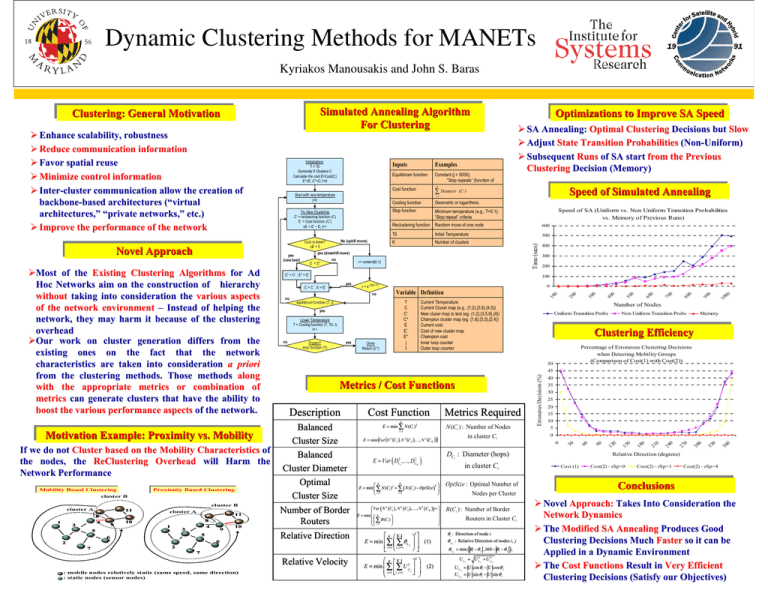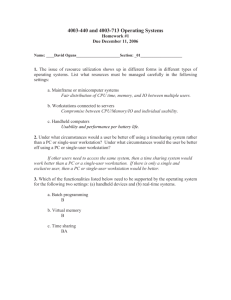Dynamic Clustering Methods for MANETs Kyriakos Manousakis and John S. Baras
advertisement

Dynamic Clustering Methods for MANETs
Kyriakos Manousakis and John S. Baras
Simulated
Simulated Annealing
Annealing Algorithm
Algorithm
For
Clustering
For Clustering
Proximity
Proximity Based
Based Clustering
Clustering
cluster B
cluster B
cluster A
1
11
8
4
3
9
cluster A
11
8
4
10
1
3
5
9
10
5
6
6
2
7
No (uphill move)
Geometric or logarithmic
Speed
Speed of
of Simulated
Simulated Annealing
Annealing
Stop function
Minimum temperature (e.g., T=0.1);
“Stop repeat” criteria
Speed of SA (Uniform vs. Non Uniform Transition Probabilities
vs. Memory of Previous Runs)
Reclustering function Random move of one node
600
T0
Initial Temperature
500
K
Number of clusters
yes (downhill move)
E’ < E*
no
r= random[0,1]
C* = C’ ; E* = E’
200
T
C
C’
C*
E
E’
E*
j
t
equilibrium function (T, j)
Lower Temperature
T = Cooling function (T, T0, t)
t++
yes
Frozen?
stop function (T)
Done
Return (C*)
10
00
90
0
80
0
70
0
60
0
50
0
40
0
10
0
Current Temperature
Current Cluser map (e.g., {1,2},{3,6},{4,5})
New cluser map to test (eg. {1,2},{3,5,6},{4})
Champion cluster map (eg. {1,6},{3,5},{2,4})
Current cost
Cost of new cluster map
Champion cost
Inner loop counter
Outer loop counter
30
0
0
Variable Definition
yes
no
300
r < e–(∆E /T)
no
no
400
100
yes
C = C’ ; E = E’
Number of Nodes
Uniform Transition Probs
Non Uniform Transition Probs
Memory
Clustering
Clustering Efficiency
Efficiency
Percentage of Erroneous Clustering Decisions
when Detecting Mobility Groups
(Comparison of Cost(1) with Cost(2))
50
Relative Direction
7
Relative Velocity
K
K
N (Ci ) : Number of Nodes
10
5
DCi : Diameter (hops)
E = Var ( DC21 ,..., DC2K )
⎛ Var ( N 22 (C11 ) , N 22 (C22 ) ,...., N 22 (CKK )) + ⎞
⎜
⎟
E = min ⎜ ⎛ KK
⎟
⎞
⎜ ⎜ ∑ B(Cii ) ⎟
⎟
⎠
⎝ ⎝ ii−−11
⎠
2
⎡ K ⎛ Cz
⎞ ⎤
E = min ⎢ ∑ ⎜ ∑ θ ri , j ⎟⎟ ⎥ (1)
⎢ z =1 ⎜⎝ i , j =1 ⎠ ⎥
⎣
⎦
B (Ci ) : Number of Border
Routers in Cluster Ci
θii : Direction of node i
θ rr : Relative Direction of nodes i, j
(
)
θ rr = min θii − θ jj ,360
, 360 − θ ii − θ jj ,
ii,,jj
U ri , j = U x2i , j + U y2i , j
(2)
Cost (1)
OptSize : Optimal Number of
Nodes per Cluster
ii,,jj
U xi , j = U cos θ i − U cos θ j
U yi , j = U sin θ i − U sin θ j
36
0
33
0
30
0
27
0
24
0
21
0
Relative Direction (degrees)
in cluster Ci
KK
⎛ KK
44 ⎞
E = min ⎜ ∑ N (Cii ) 22 + ∑ ( N (Cii ) − OptSize ) ⎟
ii−−11
⎝ ii−−11
⎠
2
⎛ K ⎡ Cz
⎤ ⎞
E = min ⎜ ∑ ⎢ ∑ U r2z ⎥ ⎟
⎜ z =1 ⎣ i , j =1 i , j ⎦ ⎟
⎝
⎠
15
0
in cluster Ci
))
20
18
0
( (
E = min (Var (N 2 (C1 ), N 2 (C 2 ),...., N 2 (C K )))
25
15
0
ii−−11
30
90
Balanced
Cluster Size
Balanced
Cluster Diameter
Optimal
Cluster Size
Number of Border
Routers
E = min ∑ N (Cii ) 22
Metrics Required
35
60
Cost Function
40
30
Description
Erroneous Decisions (%)
45
Metrics
Metrics // Cost
Cost Functions
Functions
2
: mobile nodes relatively static (same speed, same direction)
: static nodes (sensor nodes)
Cooling function
12
0
If we do not Cluster based on the Mobility Characteristics of
the nodes, the ReClustering Overhead will Harm the
Network Performance
Constant (j = 5000);
“Stop repeats” (function of
K
T);…
∑ Diameter (C i )
0
Motivation
Motivation Example:
Example: Proximity
Proximity vs.
vs. Mobility
Mobility
Examples
Equilibrium function
i −1
Try New Clustering
C’ = reclusering function (C)
E’ = Cost function (C’)
∆E = E’ – E; j++
yes
(new best)
¾Most of the Existing Clustering Algorithms for Ad
Hoc Networks aim on the construction of hierarchy
without taking into consideration the various aspects
of the network environment – Instead of helping the
network, they may harm it because of the clustering
overhead
¾Our work on cluster generation differs from the
existing ones on the fact that the network
characteristics are taken into consideration a priori
from the clustering methods. Those methods along
with the appropriate metrics or combination of
metrics can generate clusters that have the ability to
boost the various performance aspects of the network.
Inputs
Cost function
Start with new temperature
j=0
Cost is lower?
∆E < 0
Novel
Novel Approach
Approach
Mobility
Mobility Based
Based Clustering
Clustering
Initialization
T = T0
Generate K Clusters C
Calculate the cost E=Cost(C)
E*=E; C*=C; t=0
¾ SA Annealing: Optimal Clustering Decisions but Slow
¾ Adjust State Transition Probabilities (Non(Non-Uniform)
¾ Subsequent Runs of SA start from the Previous
Clustering Decision (Memory)
20
0
¾ Enhance scalability, robustness
¾ Reduce communication information
¾ Favor spatial reuse
¾ Minimize control information
¾ InterInter-cluster communication allow the creation of
backbonebackbone-based architectures (“virtual
architectures,” “private networks,” etc.)
¾ Improve the performance of the network
Optimizations
Optimizations to
to Improve
Improve SA
SA Speed
Speed
Time (secs)
Clustering:
Clustering: General
General Motivation
Motivation
Cost(2) - rSp=0
Cost(2) - rSp=1
Cost(2) - rSp=4
Conclusions
Conclusions
¾ Novel Approach: Takes Into Consideration the
Network Dynamics
¾ The Modified SA Annealing Produces Good
Clustering Decisions Much Faster so it can be
Applied in a Dynamic Environment
¾ The Cost Functions Result in Very Efficient
Clustering Decisions (Satisfy our Objectives)





